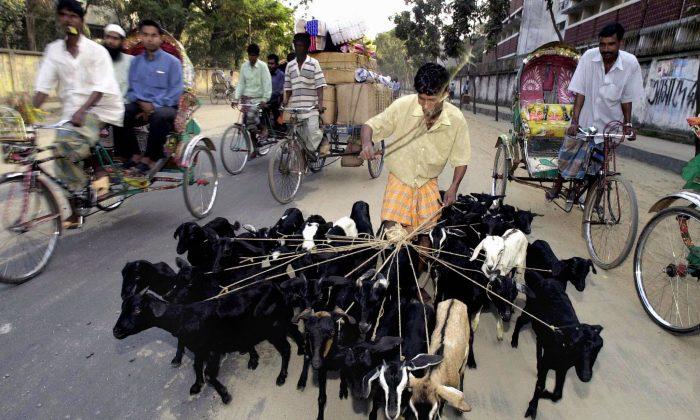Denmark: City’s homeless get a final resting place to call their own
COPENHAGEN—A section of Assistens Kirkegård – the burial spot of HC Andersen and Søren Kierkegaard – will now be a place to remember Copenhagen’s down-and-out
They may be the nameless and forsaken people of society, but on Monday, the city’s homeless were given a place of remembrance in Copenhagen’s most hallowed ground when a burial plot dedicated to the people of the street was opened at Assistens Kirkegård cemetery in Nørrebro.
The social affairs minister, Annette Vilhelmsen (Socialistisk Folkeparti), and the city’s deputy mayor for technical and environment affairs, Ayfer Baykal (SF), joined about 75 homeless people and their supporters for the opening of the cemetery plot – the final step of a plan that goes back two years. …
Copenhagen Post
Bangladesh: Deceivers always have clever innovative ideas
Just a couple of days before the Eid-ul-Azha [Islamic festival of sacrifice], a section of cattle traders are deceiving the customers by blackening the white wool of goats with hair-dye as black goats are in great demand and pricey too.
The practice, involving less than Tk 50 [64 cents], is now common in different areas as it adds a few hundred taka [100 taka is $1.30] as price of a goat, said several brokers of cattle traders at Chharabari market in Thakurgaon Sadar upazila.
During a visit to Madarganj village in Awliapur union under Thakurgaon Sadar upazila on Saturday, this correspondent saw one Nur Islam busy dying white wools of his goats with ‘five-star mini-pack hair-dye’. …
The Daily Star
Chile: Indigenous march in Chile’s capital on Columbus Day
Peaceful indigenous rights protest calling for political autonomy and a devolution of ancestral lands marred by outbreaks of violence after march.
Demonstrators took to the streets Saturday to celebrate indigenous culture, demand political self-determination and decry the government’s response to the ongoing disputes over land rights in the South of the country.
Forming a sea of color, music and tradition, thousands of demonstrators marched through downtown Santiago in support of indigenous rights this Columbus Day in a lively, but peaceful, protest.
While a carnival atmosphere and traditional customs were abundant, tensions with the Chilean government and police force were never far away.
Addressing the crowd, speakers referenced the frequently fraught relationship between Mapuche communities and the state. References to ongoing conflicts over disputed land, the treatment of incarcerated Mapuche activists and numerous allegations of police brutality were prominent in both speeches and the signs carried by demonstrators. ...
Santiago Times
Japan: ‘Kumiko’ woodcraft master turns craft into intricate art to save tradition
IIDA, Nagano Prefecture—A “kumiko” woodworking master is applying his skills to make decorative frames for Western-style rooms to preserve the traditional art form.
Kumiko, first used to decorate the temples of Kyoto 400 years ago, is a woodworking technique where wood pieces are painstakingly assembled together to make intricate grid designs. No nails or joints are used in their construction; the individual patterns called “yo,” which are inserted into the grids, create the tension that holds the work in place.
The color schemes of each piece comes from the natural wood that goes into their making and no artificial colors are used. Since World War II, kumiko has been used to create architectural detail above doorways, called “ranma,” and in Japan’s iconic sliding doors, called “shoji.” ...
Asahi
Africa: No winner for 2013 Mo Ibrahim prize for Africa governance
The Mo Ibrahim Foundation has announced there will be no winner for the African leadership prize this year.
“After careful consideration, the Prize Committee has determined not to award the 2013 Prize for Excellence in Leadership,” Mr Salim Ahmed Salim, the Chair of the Prize Committee, said.
Responding to questions on why they chose not to do so, Sudanese Industrialist Mo Ibrahim agreed that while the criteria for the prize were stringent, it was encouraging that the award already had three laureates. …
Kenya’s Daily Nation
Wales: Senghenydd centenary: Dan O'Neil on the nation’s worst mining disaster and the terrible cost of coal
Today marks 100 years since the Senghenydd mining disaster. Dan O'Neil looks at the tragedy and the terrible cost of coal throughout the centuries
We do not know his name, any more than we know the name of the first man to fall in the killing fields of the Somme. He is the Unknown Soldier of that war against nature waged in Wales since the first coal was mined at Neath in 1248. But in 1668 his was the first recorded death.
The first recorded death, for without doubt there were many before him. While we know beyond any doubt at all that there were far too many after him. ...
Deaths so frequent that as the 19th Century dawned a coroner’s inquest was regarded as unnecessary if the corpse was “only that of a collier”. The true cost of coal, then. And to those communities who knew so much woe over the years we can add the most heart-breaking name of all: Aberfan. ...
Wales Online
Canada: Demand grows for exotic veggies as nation’s palate changes
Immigration fuelling multimillion dollar demand for locally grown world crops
Anon Lololi quickly rattles off how he likes to cook callaloo, a leafy green vegetable common in his native Guyana, but not so common in kitchens and grocery stores around his Toronto-area home.
“We love it in rice,” he says. Add coconut milk, and it’s a real “delicacy.” Plus, it is chock full of nutrients, offering “more iron than spinach” and lots of Vitamin E.
But as good as callaloo may be, it’s far from being a household staple in Canadian kitchens.
Lololi would like callaloo to become more common, though. And by growing and selling it, along with produce such as okra at farmers markets in Toronto, he’s tapping into an underserved demand for ethnic vegetables that University of Guelph researchers say could be worth more than $60 million per month in the Greater Toronto Area alone. ...
Toronto Star






Friends Read Free